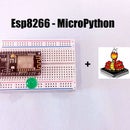Introduction: Interface Accelerometer With NodeMCU
Hey Makers,
I'm with another simple Instructable. In this Instructable we will learn how to interface ADXL335 / GY-61 called as accelerometer with NodeMCU.
Step 1: Things Needed
Hardware Requirement
- ADXL335 : Accelerometer Sensor
- NodeMCU
- Connecting Wires
- BreadBoard
- Micro USB Cable
Software Requirements
- Arduino IDE
Step 2: Description
The ADXL335 / GY-61 is a small, thin, low power, complete 3-axis accelerometer with signal conditioned voltage outputs.
The product measures acceleration with a minimum full-scale range of ±3 g.
It can measure the static acceleration of gravity in tilt-sensing applications, as well as dynamic acceleration resulting from motion, shock, or vibration.
There is no on-board regulation, provided power should be between 1.8 and 3.6VDC.
In general, ADXL335 is 3v3 compatible device, it's powered by a 3.3v source and also generates 3.3v peak outputs. It has three outputs for each axis, i.e. X, Y & Z. These are analog outputs and thus require an ADC in a micro-controller. NodeMCU solves this problem. We will be using the analog pin of NodeMCU.
Step 3: Circuit Connection
The Accelerometer module has 5 pins i.e.,
VCC - To be connected to NodeMCU +3.3v.
X - To be connected to Analog Pin A0 of the NodeMCU.
Y - NIL
Z - NIL
GND - To be connected to Ground Pin (GND) of the NodeMCU.
Note : Since NodeMCU has only one Analog Pin, you can connect either of X, Y, or Z pin to it.
Before you get started with coding you need Arduino IDE.To download Arduino IDE and for NodeMCU setup, you can check my previous instructacle.
Step 4: Let's Begin to Code
const int xPin = A0; //x-axis of the Accelerometer
void setup() {
// initialize serial communications at 9600 bps:
Serial.begin(9600);
}<p>void loop() { <br> int x = analogRead(xPin);
delay(100);
Serial.print("X-axis : ");
Serial.println(x);
}</p>Download the "Accelerometer.ino" file and open it up in the Arduino IDE.
Then Create a new sketch and paste the code below in the Arduino IDE and hit Upload.
You can tinker with it if you like based on the application, or just use it as it is.
Attachments
Step 5: Upload the Code
- Goto Tools
- Board > NodeMCU 1.0 (ESP - 12E Module)
- Port ( Choose the right Port )
**Make sure you have your NodeMCU model selected and the correct serial port ticked (see pics). Then just click the Upload button**
After you upload the code, you can see the Output on the Serial Monitor.
Step 6: Output Demonstration
That's all makers!
I hope it helps you.

Participated in the
Makerspace Contest 2017












